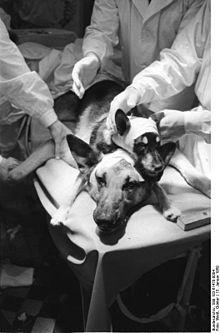Spines will Roll

Photo Via Wikipedia- Head Transplantation http://en.wikipedia.org/wiki/Head_transplant
There are people out there that will argue that nothing is better than the invention of sliced bread, but this one will have your head rolling. I’m talking about human head transplantation! This feat will be talked about this year at the surgical conference in the U.S. after Sergio Canavero of the Turin Advanced Neuromodulation Group in Italy in 2013. This type of procedure is hoped to extend and help the lives of people who have had their nerves and muscles destroyed and organs embedded with cancer, and all of this could be ready as early as 2017.
This idea was first tried out by Soviet surgeon, Vladimir Demikhov, on a dog in 1954, but the dog only lived 5 days. 16 years later, Robert White and his team completed the first successful head transplant when they moved one monkey head onto another. Even though they didn’t fuse it’s spinal cord so the monkey wasn’t able to move it’s body, it was still able to breath with outside help. The monkey lived a long life of 9 days before the body rejected the head, but because of this tried transplantation, Cavanero says “I think we are now at a point when the technical aspects are all feasible.”
Now this is where the fun part begins. Cavanero recently published a summary of techniques that could help doctors with the transplantation. Here it goes:
The recipients head and donor’s body should be cooled to extend the time that their cells can survive without oxygen.
The tissue around the neck should then be dissected where the major blood vessels are linked using tiny tubes. Cleanly severing the cords is key.
The head is then moved onto the donor’s body and the ends of the spinal cord are then fused together. The area will then be flushed with a chemical called polyethylene glycol, and followed up with several hours of injections of the same chemical.
After that, the membranes, muscles and body will be kept in a coma for a couple weeks to prevent movement and help strengthen new nerve connections.
The best part of course is when the patient finally wakes up. It’s predicted that they will be able to speak in the same voice and move their face, and in a year, they should be able to walk around. There are already people who have signed up to experience a life with a new body.
Of course there are worries that come along with a procedure as daring and extreme as this one. One of the biggest problems has been the question “what if the body rejects the head?” Well, don’t worry about that! William Mathews, chairman of the AANOS, says he doesn’t think this would be a major problem today due to the development of modern medicine and the drugs that help with the management of large amounts of tissue.
All research derives from Thomson, Helen. “First Human Head Transplant Could Happen in Two Years.” New Scienstist – Health. New Scientist, 1 Feb. 2015. Web. 2 Mar. 2015. .













kathy • Mar 19, 2015 at 10:26 am
I think this is all very sad. Animals should not be used for experimentation.
Maddy • Mar 16, 2015 at 8:26 am
Freaky article, very interesting though. Stop animal testing!